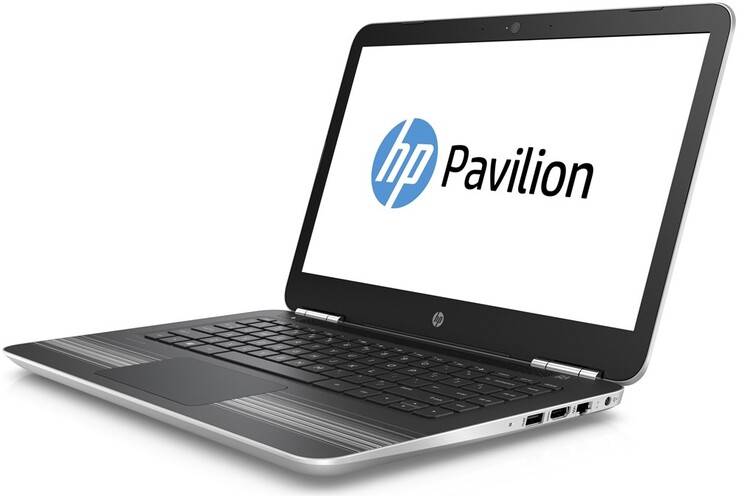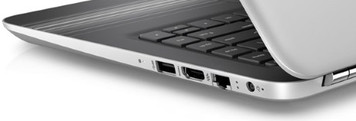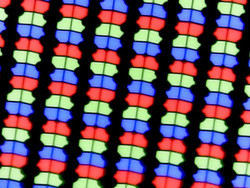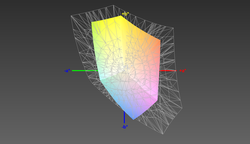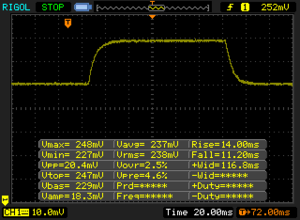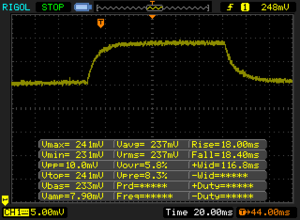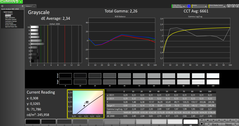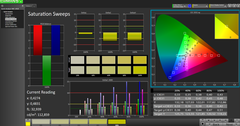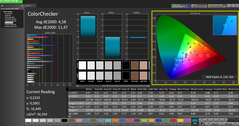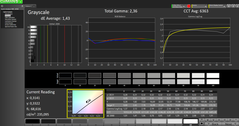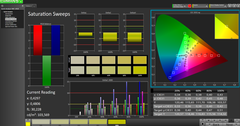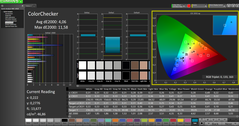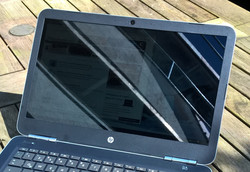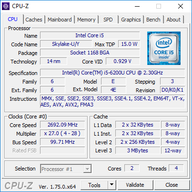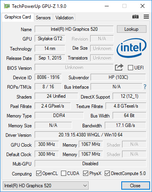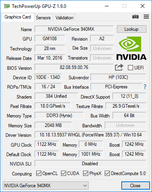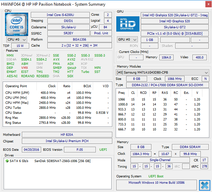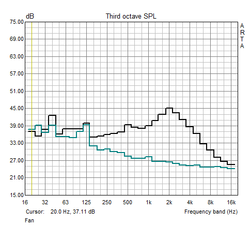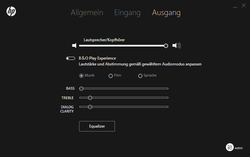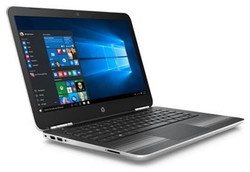HP Pavilion 14-al003ng Notebook Review

For the original German review, see here.
In the notebook market, 15-inch notebooks are definitely best sellers and achieve the highest number of sales in the consumer range. Consumers looking for a smaller notebook, most likely purchase a 13-inch notebook. In contrast, the "intermediate size" of 14 inches is particularly common in the business range.
This leads us to our test model: With the Pavilion 14, HP has released a device of the above-mentioned "intermediate size". It is supposed to supplement HP's Pavilion multimedia series at the lower-end and even attract casual gamers by combining an ultrabook CPU with a dedicated Nvidia GPU. In addition, the dGPU sets it apart from the usual 13-inch notebooks, which most often lack this feature. The bundle of dedicated graphics card, Full HD IPS display, i5 processor and 256 GB SSD is available for 699 Euros (~$780).
There are few direct competitors, since, as already mentioned above, the 14-inch size is quite unusual in the consumer range, especially if you want a dedicated GPU. The Acer Aspire E5-474G as well as the Lenovo IdeaPad 510S-14ISK are direct competitors, but we have not reviewed them so far. Thus we compare the test model to their predecessors, the IdeaPad 500S-14ISK and the Acer Aspire E5-743G.
Case & Connectivity
The Pavilion 14 largely conforms to HP's current design scheme. The lid and underside are silver colored while the inside is black. It is striking that HP has put white stripes on the palm rests. In addition, the hinge covers shine like metal (but they are made from plastic) and so does the big, central HP logo on the lid. The lid is made from metal, which feels nice to the touch. The inside and base unit are made entirely from plastic. While this is not bad per se, the plastic used feels very soft to the touch and appears cheap. This applies to the base unit especially. While the base unit twists only slightly, the lid twists slightly more. Nevertheless, the stability is all right for a relatively cheap device. The palm rests bend significantly when applying pressure in the center while it is stable along the edges. Pressure against the lid is not visible on the display. At about 1.5 kg (~3.3 pounds), the HP Pavilion 14 weighs slightly less than the Lenovo and Acer in our comparison group.
The connectivity conforms to what is commonplace in typical 13-inch and 14-inch notebooks today. However, our test model lacks a USB Type C port and one of the USB ports is still USB 2.0. The interface layout is ok. All interfaces sit on the left and right side towards the rear. Please note that an Ethernet port with cover is used. Otherwise, the relatively thick port might not have found enough space. Unfortunately, HP uses Fast Ethernet (100 Mbit/s), which unnecessarily limits the performance.
The Wi-Fi adapter likewise performs poorly. While the connection is stable, HP uses a very slow b/g/n 1x1 adapter with a maximum gross rate of 72 Mbit/s and a net rate of barely half of it.
Connectivity
| SD Card Reader | |
| average JPG Copy Test (av. of 3 runs) | |
| Dell XPS 13 2016 9350 (FHD, i7-6560U) | |
| Dell Latitude 12 E7270 | |
| HP Pavilion 14-al003ng | |
| Lenovo Ideapad 500s-14ISK | |
| maximum AS SSD Seq Read Test (1GB) | |
| Dell XPS 13 2016 9350 (FHD, i7-6560U) | |
| Dell Latitude 12 E7270 | |
| Lenovo Ideapad 500s-14ISK | |
| HP Pavilion 14-al003ng | |
| Networking | |
| iperf Server (receive) TCP 1 m | |
| Dell XPS 13 2016 9350 (FHD, i7-6560U) | |
| iperf Client (transmit) TCP 1 m | |
| Dell XPS 13 2016 9350 (FHD, i7-6560U) | |
Input Devices
The keyboard is good when compared to other devices in this price range. It uses the typical HP layout with very small vertical arrow keys and navigation keys at the right edge, which are not really subject to complaint. The typing experience is all right, not too spongy and not too hard, and the keys feature sufficient travel. Please note that the keyboard springs slightly when typing more vigorously. This is a bad property that many cheap notebooks have in common.
In contrast to the keyboard, the Synaptics touchpad is by no means good, even when compared to other devices of this category. While it is relatively big, and the surface is smooth, the integrated click mechanics of the ClickPad appears very cheap. In addition, the ClickPad clatters slightly. Unfortunately, the touchpad did not work flawlessly. It repeatedly did not respond at all for a few seconds when we tried to move the mouse pointer.
Display
HP incorporated a 14-inch display with FHD resolution (1920x1080 pixels). The panel comes from AUO (AU Optotronics) and features a glossy surface. The FHD IPS display is the only option available for the Pavilion 14 in Germany.
With an average brightness of 208 cd/m2, the panel is relatively dark. The displays of the two devices in our comparison, the Lenovo and Acer, are brighter. While the HP performs better than its competitors in contrast with 786:1, it falls behind them in color space. The AUO display does not use PWM, but it shows some backlight bleeding along the lower display edge when the display is completely dark.
We have added the XPS 13 to our comparison as a reference.
| |||||||||||||||||||||||||
Brightness Distribution: 88 %
Center on Battery: 220 cd/m²
Contrast: 786:1 (Black: 0.28 cd/m²)
ΔE ColorChecker Calman: 4.58 | ∀{0.5-29.43 Ø4.78}
ΔE Greyscale Calman: 2.34 | ∀{0.09-98 Ø5}
54.2% sRGB (Argyll 1.6.3 3D)
34.6% AdobeRGB 1998 (Argyll 1.6.3 3D)
Gamma: 2.26
CCT: 6661 K
| HP Pavilion 14-al003ng AUO203D, , 1920x1080, 14" | Lenovo Ideapad 500s-14ISK Chi Mei CMN14A7, , 1920x1080, 14" | Acer Aspire E5-473G-59QT AU Optronics AUO1B3D, , 1920x1080, 14" | Dell XPS 13 2016 9350 (FHD, i7-6560U) Sharp SHP1449 LQ133M1, , 1920x1080, 13.3" | |
|---|---|---|---|---|
| Display | ||||
| Display P3 Coverage (%) | 40.74 | 37.82 | 54.8 | |
| sRGB Coverage (%) | 60.6 | 56.9 | 82.3 | |
| AdobeRGB 1998 Coverage (%) | 42.15 | 39.07 | 56.6 | |
| Response Times | -5% | -8% | ||
| Response Time Grey 50% / Grey 80% * (ms) | 36.4 ? | 43 ? -18% | 42.8 ? -18% | |
| Response Time Black / White * (ms) | 25.2 ? | 23 ? 9% | 24.8 ? 2% | |
| PWM Frequency (Hz) | ||||
| Screen | -52% | -71% | 45% | |
| Brightness middle (cd/m²) | 220 | 249 13% | 238 8% | 385 75% |
| Brightness (cd/m²) | 209 | 235 12% | 228 9% | 350 67% |
| Brightness Distribution (%) | 88 | 87 -1% | 90 2% | 86 -2% |
| Black Level * (cd/m²) | 0.28 | 0.44 -57% | 0.54 -93% | 0.17 39% |
| Contrast (:1) | 786 | 566 -28% | 441 -44% | 2265 188% |
| Colorchecker dE 2000 * | 4.58 | 9.47 -107% | 10.64 -132% | 4.17 9% |
| Colorchecker dE 2000 max. * | 11.47 | 15.41 -34% | 7.61 34% | |
| Greyscale dE 2000 * | 2.34 | 10.22 -337% | 11.74 -402% | 5.39 -130% |
| Gamma | 2.26 97% | 2.34 94% | 2.42 91% | 2.12 104% |
| CCT | 6661 98% | 11451 57% | 13043 50% | 7404 88% |
| Color Space (Percent of AdobeRGB 1998) (%) | 34.6 | 39 13% | 36 4% | 62.7 81% |
| Color Space (Percent of sRGB) (%) | 54.2 | 57 5% | 57 5% | 99.8 84% |
| Total Average (Program / Settings) | -29% /
-44% | -71% /
-71% | 19% /
36% |
* ... smaller is better
Display Response Times
| ↔ Response Time Black to White | ||
|---|---|---|
| 25.2 ms ... rise ↗ and fall ↘ combined | ↗ 14 ms rise | |
| ↘ 11.2 ms fall | ||
| The screen shows relatively slow response rates in our tests and may be too slow for gamers. In comparison, all tested devices range from 0.1 (minimum) to 240 (maximum) ms. » 59 % of all devices are better. This means that the measured response time is worse than the average of all tested devices (20.2 ms). | ||
| ↔ Response Time 50% Grey to 80% Grey | ||
| 36.4 ms ... rise ↗ and fall ↘ combined | ↗ 18 ms rise | |
| ↘ 18.4 ms fall | ||
| The screen shows slow response rates in our tests and will be unsatisfactory for gamers. In comparison, all tested devices range from 0.165 (minimum) to 636 (maximum) ms. » 51 % of all devices are better. This means that the measured response time is worse than the average of all tested devices (31.6 ms). | ||
Screen Flickering / PWM (Pulse-Width Modulation)
| Screen flickering / PWM not detected | ||
In comparison: 53 % of all tested devices do not use PWM to dim the display. If PWM was detected, an average of 8101 (minimum: 5 - maximum: 343500) Hz was measured. | ||
The Pavilion pulls ahead from its rivals in color representation and even more in viewing angles, which are good, as usual for IPS panels (even though they cannot keep up with very high-end IPS displays), since the two competitors use TN panels. From the successors at least the Lenovo 510s-14ISK features an IPS display.
Due to the glossy surface and the low brightness, the display is not suitable for outdoor use. It is even difficult to read from the screen in the shade.
Performance
As it is a Pavilion, the test model is designed for multimedia. With a 15 W ULV CPU and a dedicated graphics card, the device is sufficiently equipped for this purpose.
Apart from the tested configuration with i5 CPU, HP offers another model of the HP Pavilion 14, which is identical to the test model except for the CPU. The 100 Euros (~$112) more expensive model uses an i7-6500U.
HP is not thrifty as to RAM. Both variants come with 8 GB DDR4-2133 RAM, however in a single module. As a result, RAM runs in slow single channel mode.
Processor
The built-in Core i5-6200U is a very frequently used 15 W dual-core CPU. Just as all Skylake CPUs, the Core i5 is soldered. In addition, the processor supports Hyperthreading. The CPU features a base clock of 2.3 GHz and a turbo clock of 2.8 GHz.
The benchmarks show that HP has optimized the cooling well. The CPU could constantly clock at 2.6 GHz in the Cinebench R15 test, which is almost the maximum turbo boost that is possible in multi-core tests. The CPU does not reach the maximum turbo clock in the single-core test.
Compared to the competition, the Pavilion gets the most of the i5 processor. The ThinkPad T460s only performs better as the manufacturer has increased the TDP to 25 W. Thus, it can be considered a reference system for the maximum performance of the i5-6200U. However, only the multi-core test benefits from the small performance gain.
System Performance
The system performance is subjectively very good, at least when using offline contents. The PCMark 8 benchmark proves this and the laptop ranks in between its rivals. In general, the differences are only small in this benchmark and it might have an impact on the result whether a PCIe SSD is used or RAM runs in single channel mode (as in our test model) instead of in dual channel mode.
| PCMark 8 Home Score Accelerated v2 | 3238 points | |
Help | ||
Storage Devices
Our test model did not use a PCIe SSD nor can it be retrofit. HP has incorporated a 256 GB SSD from SanDisk, which performs neither exceptionally good nor terribly bad. It can easily outperform a really slow SSD such as the one in the ThinkPad T460s. This is all the more true for the SSHD in the Acer, but it certainly cannot keep up with PCIe SSDs. In addition, it cannot reach the performance of the Samsung SATA III SSD in the Lenovo IdeaPad 500S-14ISK. Basically, the SSD used is not the cheapest or slowest, but there are faster SSDs.
| HP Pavilion 14-al003ng SanDisk Z400s 256 GB M.2 2280 | Dell XPS 13 2016 9350 (FHD, i7-6560U) Samsung PM951 NVMe MZ-VLV256D | Lenovo Ideapad 500s-14ISK Samsung PM871 MZYLN256HCHP | Acer Aspire E5-473G-59QT Seagate ST500LM000 Solid State Hybrid Drive | Lenovo ThinkPad T460s-20F9003SGE Samsung CM871 MZ7LF192HCGS | Apple MacBook Pro Retina 13 inch 2015-03 Apple SSD SM0128G | |
|---|---|---|---|---|---|---|
| CrystalDiskMark 3.0 | 99% | 63% | -89% | -47% | 77% | |
| Read Seq (MB/s) | 469.3 | 1131 141% | 507 8% | 113.7 -76% | 446.5 -5% | 1403 199% |
| Write Seq (MB/s) | 309.1 | 311.4 1% | 309.5 0% | 110.1 -64% | 171.1 -45% | 657 113% |
| Read 4k (MB/s) | 14 | 39.63 183% | 36.24 159% | 0.369 -97% | 5.78 -59% | 20.95 50% |
| Write 4k (MB/s) | 73.9 | 133.9 81% | 93.3 26% | 0.762 -99% | 35.47 -52% | 32.43 -56% |
| Read 4k QD32 (MB/s) | 149.5 | 399.7 167% | 394.5 164% | 0.377 -100% | 94.9 -37% | 343.6 130% |
| Write 4k QD32 (MB/s) | 204.6 | 245.6 20% | 241.6 18% | 0.738 -100% | 36.43 -82% | 254.4 24% |
Graphics Card
The Nvidia GeForce 940MX is a mid-range GPU of the Maxwell generation, which comes with 2 GB DDR3 VRAM here. Its maximum clock rate is 1188 MHz, which is not far from the 940MX's maximum possible Turbo of 1242 MHz.
Compared to the Lenovo IdeaPad 500S-14ISK with Nvidia GeForce 940M it becomes apparent that the difference between 940M and 940MX is quite small. The newer GPU is only 6% faster. If the manufacturer had used GDDR5 VRAM, higher performance might have been possible. The bigger Pavilion 15 sibling with the 950M is significantly faster. However, the Pavilion 14 performs much better than devices with Intel HD 520.
| 3DMark 11 - 1280x720 Performance GPU | |
| HP Pavilion 15-ak003ng | |
| HP Pavilion 14-al003ng | |
| Lenovo Ideapad 500s-14ISK | |
| Apple MacBook Pro Retina 13 inch 2015-03 | |
| Lenovo ThinkPad T460s-20F9003SGE | |
| 3DMark 11 Performance | 2553 points | |
Help | ||
Gaming Performance
With an i5 CPU and Nvidia GPU, the Pavilion can indeed run several games in medium details. We used Dirt Rally for a test, which runs in medium settings without problems. There is even some room for increasing a few settings. If you want to play games occasionally, the Pavilion 14 is definitely capable of this. However, you have to accept that the game cannot be played in maximum settings.
| low | med. | high | ultra | |
|---|---|---|---|---|
| Dirt Rally (2015) | 106.2 | 34.97 | 26.07 | 14.93 |
Emissions & Energy
System Noise
The cooling system of the Pavilion 14 is a blessing and a curse. Why is it a blessing? We will discuss this in the section about temperature below. Here we will explain why it is a curse.
While idling, the fan of the Pavilion 14 is never still. This would not be bad if the fan did not produce an annoying whining noise and often pulsates. HP might need to fix this with a firmware update. When you are in a quiet environment, these two fan characteristics are very annoying, especially since the fan never turns off.
The fan gets very loud under full load and very audible. However, this is an unrealistic scenario.
Noise level
| Idle |
| 29.2 / 29.2 / 30.8 dB(A) |
| Load |
| 38 / 44.3 dB(A) |
 | ||
30 dB silent 40 dB(A) audible 50 dB(A) loud |
||
min: | ||
Temperature
As annoying as the fan is the Pavilion remains cool. In particular, the stress test shows that it does not get loud without reason: When Prime95 and FurMark run for one hour, the CPU remains at its initial clock rate of 2.4 GHz. It does not throttle at all; the clock rate does not even fall to the base clock. In addition, the case does not get remarkably hot. The CPU temperature increases to a maximum of 77 °C (170.6 °F) and the case never exceeds 44.9 °C (112.82 °F) with a hotspot in the rear area. This is uncomfortable, yet not critical. The Pavilion 14 manages temperatures quite well in view of the fact that its 19 mm (~0.75 in) case houses a 15 W i5 and a mid-range GPU from Nvidia.
(±) The maximum temperature on the upper side is 44.1 °C / 111 F, compared to the average of 36.9 °C / 98 F, ranging from 21.1 to 71 °C for the class Multimedia.
(±) The bottom heats up to a maximum of 44.9 °C / 113 F, compared to the average of 39.2 °C / 103 F
(+) In idle usage, the average temperature for the upper side is 30.1 °C / 86 F, compared to the device average of 31.3 °C / 88 F.
(+) The palmrests and touchpad are cooler than skin temperature with a maximum of 29.1 °C / 84.4 F and are therefore cool to the touch.
(±) The average temperature of the palmrest area of similar devices was 28.7 °C / 83.7 F (-0.4 °C / -0.7 F).
Speakers
Certainly, speakers are important in a multimedia notebook. While external speakers and headphones obviously perform better, the integrated speakers should still not be poor. HP promises that the Pavilion 14 will deliver a good sound. Finally, a Bang & Olufsen logo is on the palm rests. Certainly, there is not only a logo, but also the software. HP has installed an equalizer software for tuning the sound. If you want authentic sound, you had better disable the software. However, if you want maximum volume, the B&O software is very useful. Even without the software, the speakers are not bad. They come quite close to the MacBook reference system, even though the latter performs better in the medium and low frequency range.
Frequency diagram in comparison (checkboxes at the top can be checked/unchecked!)
Value 1: pink noise 100% Vol.; Value 2: audio off
Power Consumption
The power consumption of the Pavilion 14 is within normal range. Since it uses a dedicated Nvidia GPU, the notebook indeed requires more energy under load than similar devices with Intel GPUs. When idle or under low load, the affect should not be too big, since the Optimus technology is used. Thus, the Intel GPU is active most of the time, since the Nvidia GPU only runs graphically intensive applications such as games.
| Off / Standby | |
| Idle | |
| Load |
|
Key:
min: | |
Battery Life
HP uses a lithium-polymer battery rated at 41 Wh in the Pavilion 14. Our test model performs better than the Lenovo and the Acer with it. Lenovo especially, made a mistake by not improving the battery life with the frugal 15 W processor, but incorporating smaller batteries. However, other, even slimmer and more mobile devices, such as the ThinkPad T460s and the XPS 13, come with even bigger batteries, though they are also more expensive. With 5:29, the battery life of the Pavilion 14 is all right and even not so bad for a relatively cheap multimedia notebook.
Pros
Cons
Verdict
With the Pavilion 14-al003ng, HP delivers a mixed bag. Several components are convincing while others are not at all. Pros are for example that the device does not even throttle in the stress test. Nowadays several devices fail to manage that. In addition, the speakers are not poor and the Nvidia GPU can indeed run several games smoothly. Moreover, the display has several good characteristics. Especially the IPS technology increases the subjective quality impression.
On the other hand, there are also many cons. While the display uses the IPS technology, HP should have incorporated a slightly brighter, anti-reflective panel. Glare is often very annoying when using the device and makes use in bright environments almost impossible. Unfortunately, the case does not appear very high-end and the ClickPad has several annoying properties. In addition, the fan is very annoying, since it runs permanently and occasionally pulsates.
It appears that HP wants to dazzle customers with good specifications. The Pavilion sounds really good on paper with SSD, Nvidia GPU, and FHD IPS display. In return, HP has cut costs on the basics.
The negative aspects predominate. However, the decisive factor against a recommendation of the HP Pavilion is the communication hardware. Actually, it is already unforgivable that HP only incorporates Fast Ethernet in a 700 Euros (~$782) notebook, but the performance of the integrated Wi-Fi module is horrible. In a time where the Internet gets more and more important and you download many contents like games and films, its performance is simple insufficient.
Note: We decreased the rating by 3% because of the poor performance of the Wi-Fi adapter.
HP Pavilion 14-al003ng
- 08/08/2016 v5.1 (old)
Benjamin Herzig




